The Science of PCBs: Mitigating the Environmental Effects
- Last Updated: June 12th, 2025

Attorney Jessie Paluch, founder of TruLaw, has over 25 years of experience as a personal injury and mass tort attorney, and previously worked as an international tax attorney at Deloitte. Jessie collaborates with attorneys nationwide — enabling her to share reliable, up-to-date legal information with our readers.
Legally Reviewed
This article has been written and reviewed for legal accuracy and clarity by the team of writers and legal experts at TruLawsuit Info and is as accurate as possible. This content should not be taken as legal advice from an attorney. If you would like to learn more about our owner and experienced injury lawyer, Jessie Paluch, you can do so here.
Fact-Checked
TruLawsuit Info does everything possible to make sure the information in this article is up to date and accurate. If you need specific legal advice about your case, contact our team by using the chat on the bottom of this page. This article should not be taken as advice from an attorney.
Key Takeaways:
- The molecular structure of PCBs includes two benzene rings that are linked by a variable number of chlorine atoms that accounts for a broad range of potential effects on the environment and human health.
- The science of PCBs reveals that their inertness also means that once released into the environment, they do not readily break down and can persist for long periods.
- This persistence leads to their bioaccumulation in animal tissue and biomagnification up the food chain, potentially affecting human health.
Overview of the Science of PCBs
On this page, we’ll discuss the science of PCBs, including PCB chemical structure and properties, strategies for reducing environmental exposure to PCBs, scientific research on the toxicity of PCB exposure, and much more.
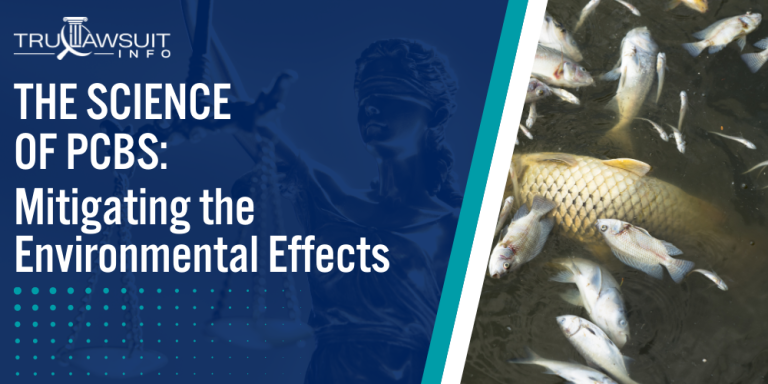
Intro to the Science of PCBs
PCBs are a class of synthetic organic chemicals that were widely used in industrial and commercial applications before being banned in the late 1970s due to their toxicity and persistence in the environment.
Here are some key scientific aspects of PCBs:
- Chemical Structure: PCBs consist of two benzene rings with varying numbers of chlorine atoms attached, resulting in 209 possible congeners.
- Physical Properties: PCBs are non-flammable, chemically stable, and have high boiling points, making them ideal for use in electrical equipment and heat transfer fluids.
- Environmental Persistence: PCBs are highly resistant to degradation and can persist in the environment for decades, accumulating in soil, water, and living organisms.
- Health Effects: Exposure to PCBs has been linked to various adverse health outcomes, including cancer, reproductive and developmental disorders, and immune system dysfunction.
If you or a loved one has experienced adverse health conditions after being exposed to PCB chemicals, you may qualify to pursue compensation.
Contact TruLawsuit Info using the chat on this page to receive an instant case evaluation to determine if you qualify to file a PCB lawsuit today.
Table of Contents
Understanding PCBs: Scientific Approaches to Mitigation
To effectively address polychlorinated biphenyls (PCBs) contamination, we must understand their behavior, toxicity, and the science guiding mitigation efforts.
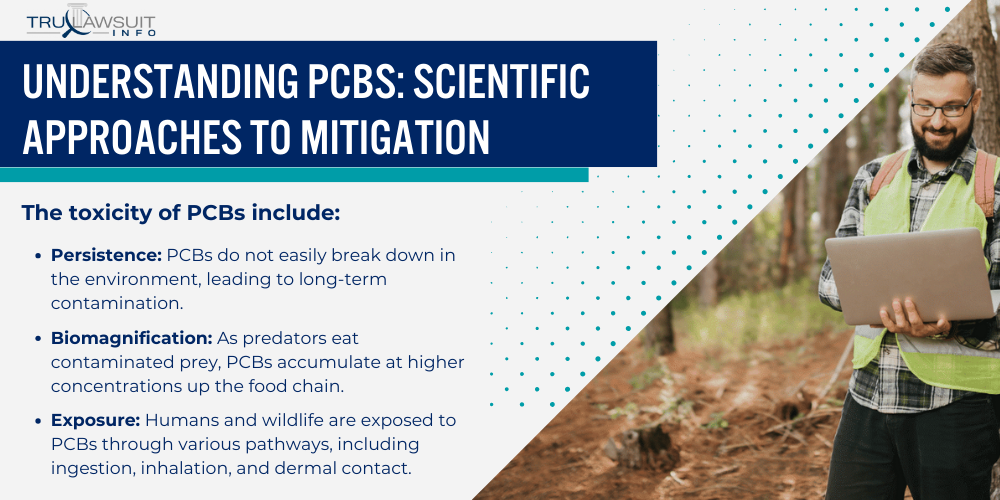
This section examines cutting-edge research and strategies developed to diminish the footprint of these hazardous substances.
Deep Dive into the Science Behind PCB Behavior and Toxicity
PCBs display a range of toxic effects due to their chemical stability and lipid solubility.
Research into PCB congeners — individual PCB molecules with distinct properties — has revealed they are a complex group of persistent organic pollutants.
This complexity affects their environmental behavior and potential harm to human health.
The Toxicity of PCBs:
- Persistence: PCBs do not easily break down in the environment, leading to long-term contamination.
- Biomagnification: As predators eat contaminated prey, PCBs accumulate at higher concentrations up the food chain.
- Exposure: Humans and wildlife are exposed to PCBs through various pathways, including ingestion, inhalation, and dermal contact.
- Health Risks: Exposure to PCBs has been linked to several adverse health outcomes, such as endocrine disruption and a higher exposure risk of certain cancers.
Innovations in Protective Measures Against Environmental PCB Contamination
The Environmental Protection Agency (EPA) has taken a proactive stance.
It has spurred developments in strategies to prevent and control PCB contamination in ecosystems and urban environments, notably at hazardous waste sites.
Advances in Environmental Protection:
- Containment: Capping and isolating contaminated sites to prevent leaching into the environment.
- Detoxification: Deploying methods such as bioremediation, where microorganisms break down PCBs.
- Chemical Disposition: Innovations in chemical methods to destroy PCBs, rendering them harmless.
- Policy Measures: Establish strict guidelines for industries to limit the production and release of new PCBs.
Developing Guidelines for Minimizing Environmental Exposure to PCBs
Collaborative efforts between scientific communities and regulatory agencies have created comprehensive guidelines aimed at reducing estimated PCB exposure pathways.
Exposure Mitigation Strategies:
- Monitoring: Systematic surveillance of PCB levels in soil, water, and air.
- Risk Assessment: Evaluating the PCB primary exposure route risk in different environments to prioritize cleanup.
- Education: Informing the community about different PCB exposure pathways and how to reduce personal risk.
- Legislation: Developing and enforcing laws to govern the management and disposal of PCB-containing materials.
Addressing the challenges posed by PCB contamination can be achieved by understanding these factors and implementing informed strategies.
Through scientific approaches to mitigation, we can help protect both the environment and human health.
Prioritizing Ecological Health in Areas Affected by PCBs
The ecological health of areas contaminated with polychlorinated biphenyl exposures requires targeted interventions.
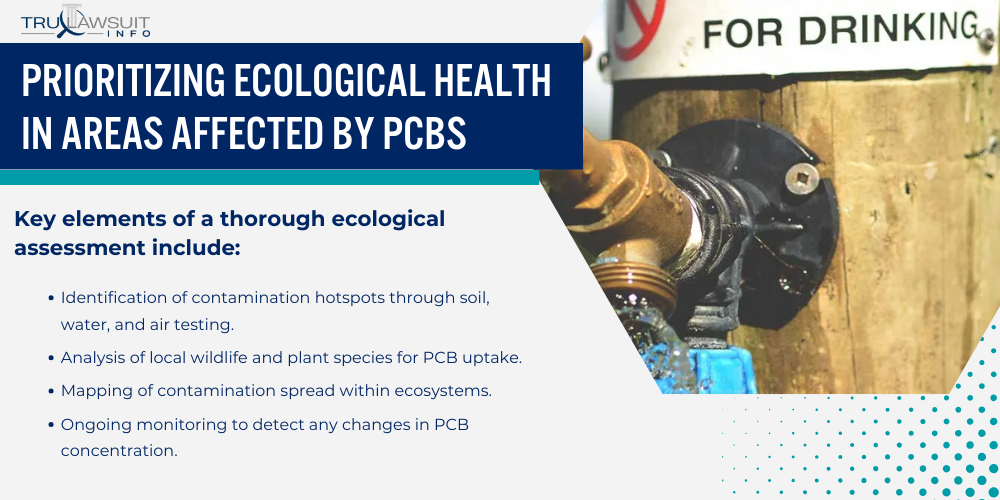
Effective strategies and thorough assessments are essential for the remediation and recovery of these environments.
Comprehensive Environmental Assessments for PCB Contamination
Assessing the scale of PCB contamination is a fundamental first step in environmental health recovery efforts.
Key elements of a thorough assessment include:
- Identification of contamination hotspots through soil, water, and air testing.
- Analysis of local wildlife and plant species for PCB uptake.
- Mapping of contamination spread within ecosystems.
- Ongoing monitoring to detect any changes in PCB concentration.
Strategic Plans for Cleanup with Emphasis on Ecosystem Recovery
Once the assessment is complete, creating a blueprint for cleanup with the aim of ecosystem restoration becomes imperative.
Strategic steps should encompass:
- Selection of cleanup methods that reduce further environmental disruption.
- Prioritization of sites based on the severity of contamination and ecological sensitivity.
- Engagement with local communities to ensure sustainable practices post-remediation.
- Implementation of technologies focused on the removal or stabilization of PCBs in affected environments.
Mandatory Ecological Certifications in Areas with PCB Exposure
Instituting mandatory ecological certifications ensures ongoing vigilance and environmental health safety standards.
Certification processes involve:
- Establishing benchmarks for safe PCB levels in local environments.
- Regular reassessment of areas post-cleanup to confirm ecological recovery.
- Enforcing compliance with environmental regulations for businesses operating in these areas.
- Encouraging transparency and accountability through public reporting of ecological health status.
These efforts underscore the necessity for a committed approach to removing harmful PCBs and fostering a thriving ecological system afterward.
Strategies for Reducing Environmental Exposure to PCBs
Reducing environmental exposure to PCBs requires targeted actions that address contaminated sites and prevent the further release of these toxic substances.
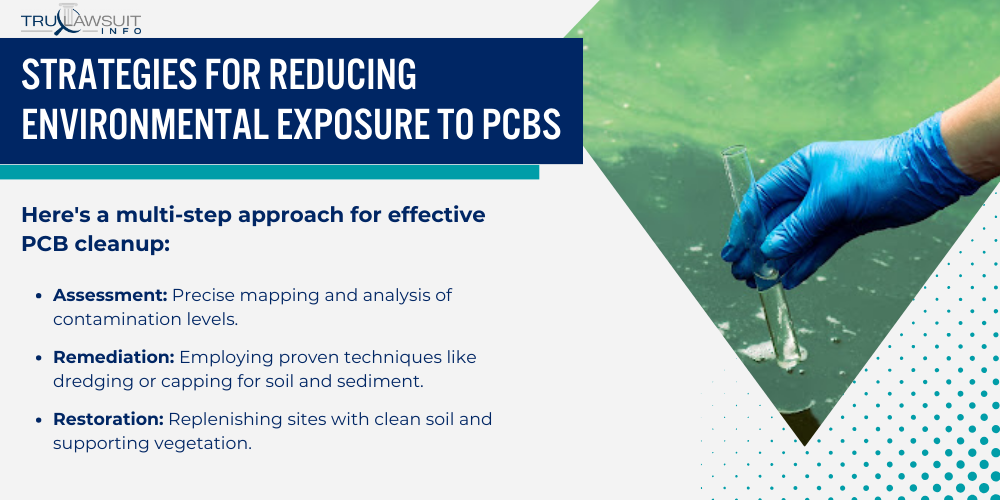
Below are focused strategies to mitigate PCB contamination, ensure the ecosystem’s health, and advocate for policies that shield communities from the adverse effects of PCBs.
Implementing Science-Based Cleanups to Minimize PCB Contamination
Science-based cleanup efforts are essential for addressing areas with PCB-contaminated soil.
The Environmental Protection Agency (EPA) spearheads initiatives that adhere strictly to research-backed methodologies for removing or containing PCBs in the environment.
Here’s a multi-step approach for effective PCB cleanup:
- Assessment: Precise mapping and analysis of contamination levels.
- Remediation: Employing proven techniques like dredging or capping for soil and sediment.
- Restoration: Replenishing sites with clean soil and supporting vegetation.
- Monitoring: Continuous surveillance to ensure the effectiveness of the cleanup.
Regular reviews of these methods by the EPA are essential to refine strategies and ensure they remain effective.
Integrating Ecosystem Health into Performance and Risk-Based Cleanup
Considering the ecosystem’s health is crucial when planning and executing PCB cleanup.
Balancing environmental protection with cleanup efforts can lead to more sustainable and beneficial outcomes for both nature and human communities.
Key Strategies for Ecosystem-Friendly PCB Cleanup:
- Risk Assessment: Estimating the impact of PCBs on local wildlife and habitats.
- Biodiversity Conservation: Prioritizing areas with high ecological value.
- Green Remediation: Using less intrusive methods that protect plant and animal life.
- Community Involvement: Engaging local stakeholders in the cleanup process to balance human and ecological considerations.
Such strategies go hand in hand with safeguarding the diversity and richness of the affected ecosystems.
Policy Advocacy for Comprehensive Insurance Against PCB Damage
Advocacy for stronger policies provides a crucial backdrop for PCB cleanup and environmental protection.
Legislation can enforce strict standards and offer comprehensive insurance against the damage caused by PCBs.
Here are the essential policy areas to address PCB contamination:
- Prevention policies: Establishing regulations that prevent new PCB contamination.
- Liability laws: Enforcing accountability for parties responsible for PCB pollution.
- Funding for research: Securing resources for advanced PCB detection and cleanup technologies.
- Community engagement: Empowering affected populations to contribute to policy-making processes.
Policies at both the national and local levels must adapt continually to the latest scientific findings to ensure they effectively address the challenges posed by PCBs in the environment.
Ensuring Safe PCB Disposal to Protect the Environment
Effective PCB disposal is vital to preventing environmental contamination from hazardous waste sites and improperly discarded electrical equipment containing PCB mixtures.
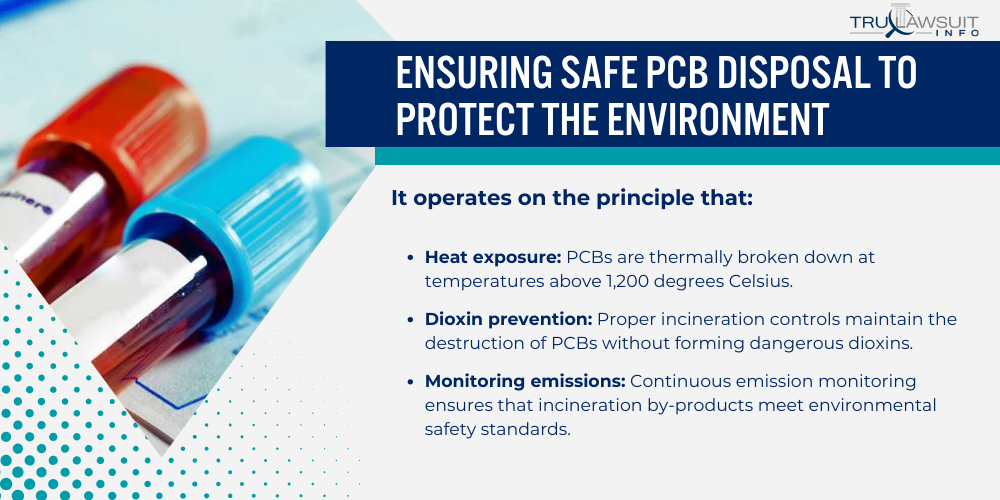
Safe practices deter illegal or improper disposal and ensure that PCB waste does not threaten ecosystems and human health long-term.
Science-Backed High-Temperature Incineration for PCB Waste
High-temperature incineration is one of the most reliable methods for destroying PCBs.
It operates on the principle that:
- Heat exposure: PCBs are thermally broken down at temperatures above 1,200 degrees Celsius.
- Dioxin prevention: Proper incineration controls maintain the destruction of PCBs without forming dangerous dioxins.
- Monitoring emissions: Continuous emission monitoring ensures that incineration by-products meet environmental safety standards.
- Certified facilities: Only facilities meeting strict EPA guidelines for high-temperature incineration are permitted to handle PCB waste.
Advancements in Alternative Disposal to Prevent PCB Spread
PCBs, or polychlorinated biphenyls, are a group of persistent organic pollutants that pose a significant environmental threat.
Safe and effective disposal methods are crucial to prevent their spread.
Beyond incineration, research has led to innovative disposal techniques:
- Chemical methods: New chemical processes can dechlorinate PCBs, rendering them less harmful.
- Biological degradation: Certain microorganisms can metabolize PCBs, although this is a developing field.
- Looking ahead: Scientists are exploring the possibilities of using nanotechnology for PCB disposal.
- Real-world application: Pilot programs are assessing the efficacy and safety of these methods before widespread implementation.
Ecological Safety in PCB Waste Management and Landfill Approvals
To ensure the environment’s and public health safety, landfills accepting PCB-laden waste must undergo rigorous approval processes established by the Environmental Protection Agency (EPA).
Landfills that accept PCB-laden waste must clear stringent Environmental Protection Agency (EPA) approval benchmarks:
- Leak prevention: Landfills must have systems in place to prevent PCB waste from leaking into the ground and water sources.
- Regular inspections: Ongoing monitoring for potential leaks or contamination is required.
- Secure containment: Effective design and engineering controls are crucial to contain PCBs.
- Public health: Measures to safeguard against threats to human health are mandatory as per EPA regulations outlined in Title 40 of the Code of Federal Regulations.
Collaborative Efforts for Eco-Friendly PCB Disposal Methods
The safe and responsible disposal of PCBs (Polychlorinated Biphenyls) requires a multi-pronged approach that unites government regulations, industry best practices, and scientific advancements.
This collaboration ensures both environmental protection and public health.
Collaboration between government, industry, and scientists is key to developing safe disposal practices:
- EPA guidelines: Provide a framework for processing PCB waste that protects the environment and public health.
- Industry compliance: Ensures industries follow proper disposal methods and seek EPA-approved techniques.
- Information sharing: Researchers and institutions share findings to improve PCB disposal standards.
- Community involvement: Public education initiatives aim to prevent illegal dumping and promote awareness of proper disposal channels.
Proper disposal of PCBs is critical to maintaining a safe environment and preventing future contamination of natural resources and living spaces.
Streamlining Approvals with a Focus on Reducing PCB Contamination
Effective approaches to reducing PCB contamination include streamlining cleanup approval processes and incorporating advanced environmental science into EPA decisions.
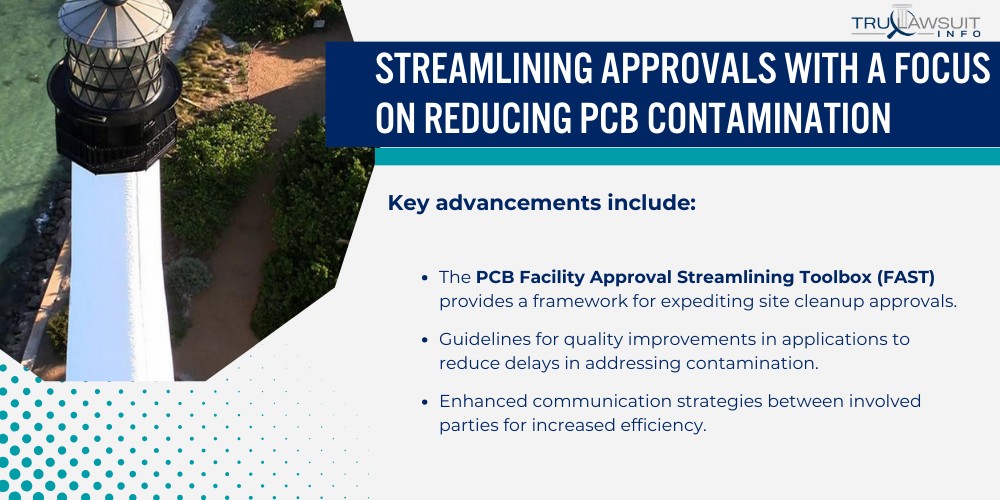
This focus ensures ecosystems are protected while maintaining compliance with the Toxic Substances Control Act.
Simplifying Cleanup Application Processes to Protect Ecosystems
The Environmental Protection Agency (EPA) has designed tools to expedite the cleanup and disposal process for polychlorinated biphenyls (PCBs).
Responsible parties and regulators can now navigate the intricacies of environmental remediation with more ease.
Key advancements include:
- The PCB Facility Approval Streamlining Toolbox (FAST), which provides a framework for expediting site cleanup approvals.
- Guidelines for quality improvements in applications to reduce delays in addressing contamination.
- Enhanced communication strategies between involved parties for increased efficiency.
- Adoption of collaborative problem-solving models to ensure regulatory compliance and effective cleanup.
These advancements enable quicker response to PCB contamination, protecting ecosystems from the hazardous impacts of these chemicals.
Additional details on the FAST initiative can be found on EPA’s website.
Influencing EPA Decisions with Cutting-Edge Environmental Science
The EPA integrates current environmental science to inform its regulatory decisions on PCB cleanups.
This forward-thinking approach facilitates scientifically informed strategies that are both practical and robust, leading to the following:
- Improved management of PCB remediation waste based on its concentration.
- Streamlined regulations that aid in swift cleanup while ensuring public safety.
- A clear understanding of the as-found concentration measurement is vital for determining appropriate responses.
- Regular updates to keep pace with the evolving field of environmental science.
Scientific developments are essential in refining techniques for managing and disposing of PCBs with minimal environmental impact.
Emergency Environmental Protocols for PCB Contamination
When handling PCB contamination, it’s essential that emergency protocols are tailored to address this toxic hazard efficiently and with due regard to human health and the environment.
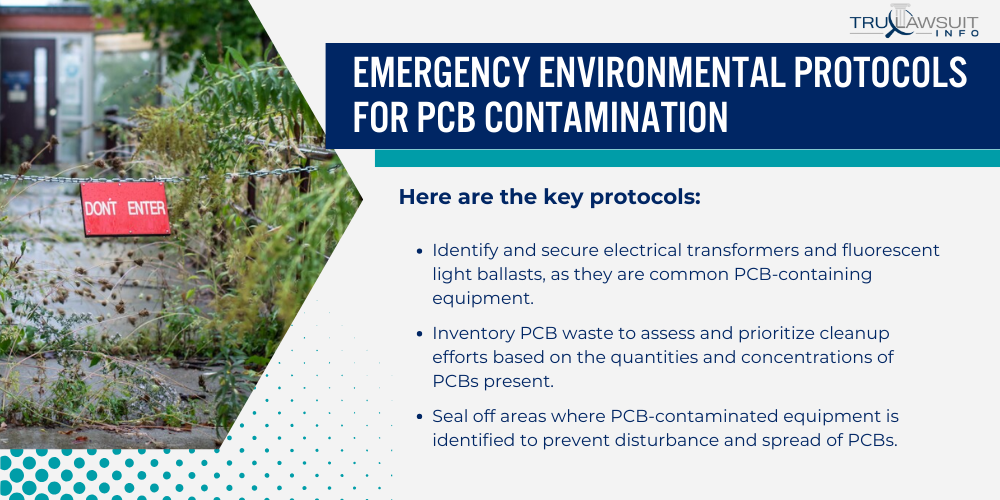
These steps are critical, especially considering PCBs are listed as probable human carcinogens.
Preparing for Effective PCB Waste Management After Ecological Disasters
Effective PCB waste management is vital following ecological disasters to prevent the further spread of contamination.
Here are the key protocols:
- Identify and secure electrical transformers and fluorescent light ballasts, as they are common PCB-containing equipment.
- Inventory PCB waste to assess and prioritize cleanup efforts based on the quantities and concentrations of PCBs present.
- Seal off areas where PCB-contaminated equipment is identified to prevent disturbance and spread of PCBs.
- Coordinate with local environmental authorities to open communication channels and alignment on procedural standards for PCB waste disposal.
These measures demand collaboration between agencies and experts familiar with PCB-specific risks and regulations.
For more detailed frameworks, one can refer to the guidelines detailed in the EPA’s management of PCB remediation waste.
Safeguarding Natural Habitats from PCB-Contaminated Equipment
The swift identification and containment of PCBs in equipment are crucial first steps in protecting ecosystems.
Leaking PCBs can harm wildlife through direct contact or by entering the food chain.
Protecting ecosystems involves swift action to contain PCBs found in equipment:
- Place visible signage around areas impacted by PCB leaks to restrict access and protect local wildlife.
- Launch procedures to decontaminate soil, water bodies, and foliage potentially impacted by PCBs.
- Invest in technology that helps trace PCB movement in the environment to safeguard unaffected areas preemptively.
- Work alongside wildlife experts to mitigate any long-term ecological damage caused by the contamination and implement proactive measures.
Preserving natural habitats from PCB exposure requires dedicated efforts to identify and contain potential exposure routes.
For the latest on PCB regulations and environmental safety measures, reviewing the updates to PCB cleanup and disposal regulations is helpful.
Legal Framework for Environmental Protection from PCBs
The regulation of Polychlorinated Biphenyls (PCBs) involves detailed legislation to manage and mitigate environmental and health risks associated with these substances.
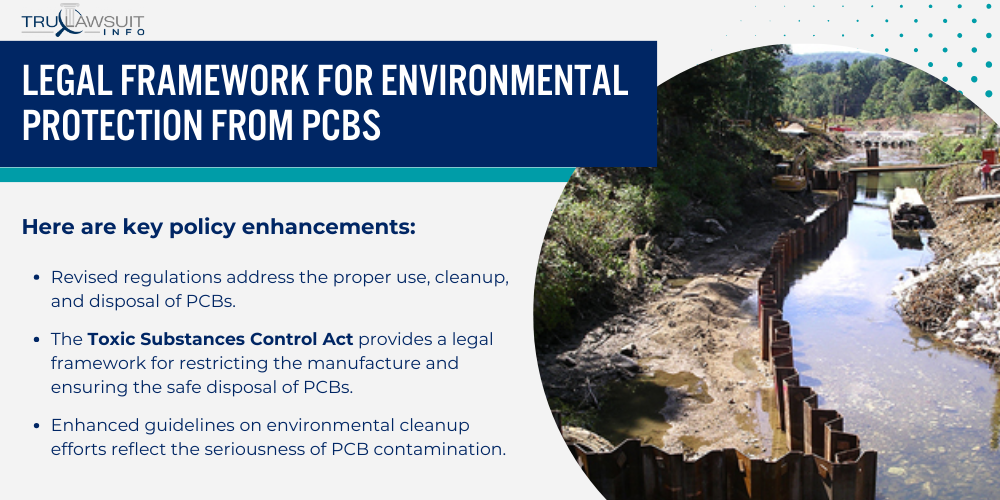
Strengthening Policies to Combat Environmental PCB Exposure Risks
Polychlorinated Biphenyls (PCBs) have been recognized as a hazardous environmental pollutant, prompting rigorous regulatory measures.
The Environmental Protection Agency (EPA) has been pivotal in setting standards to monitor and reduce PCB background levels worldwide.
Here are key policy enhancements:
- Revised regulations address the proper use, cleanup, and disposal of PCBs.
- The Toxic Substances Control Act provides a legal framework for restricting the manufacture and ensuring the safe disposal of PCBs.
- Enhanced guidelines on environmental cleanup efforts reflect the seriousness of PCB contamination.
- Education initiatives by the EPA convey the dangers posed by PCBs, empowering communities to identify and report violations.
Ensuring Accountability and Protection for Ecosystems Affected by PCBs
The EPA ensures that entities who have historically used or produced PCBs account for environmental damage and contribute to remediation efforts.
Targeted regulations underscore the need for comprehensive ecological protection:
- Strict enforcement of violations related to PCB usage and disposal.
- Audits and surveillance programs to monitor ecosystems for PCB presence.
- Clear disposal guidelines facilitate proper handling and prevent further contamination.
- Support for research on the long-term effects of PCBs aids in developing better remediation technologies.
The EPA endeavors to safeguard nature and public health from PCBs’ irreversible impact through these measures.
Advancing Environmental Science in PCB Contamination Cleanup
Polychlorinated biphenyls (PCBs) accumulation in ecosystems presents significant health risks due to their toxic and persistent nature.
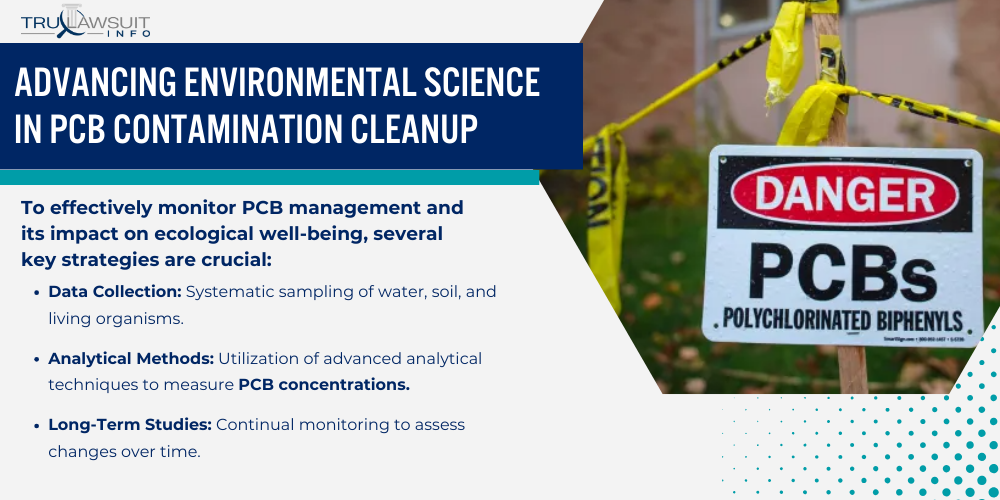
The advancement of environmental science has led to new initiatives and technologies aimed at reducing background PCB concentrations and promoting ecological recovery.
Monitoring PCB Management Initiatives for Ecological Well-Being
Effective monitoring is vital for evaluating the success of PCB management strategies.
Environmental scientists are developing more sensitive methods to track PCB levels and their impact on ecosystems.
To effectively monitor PCB management and its impact on ecological well-being, several key strategies are crucial:
- Data Collection: Systematic sampling of water, soil, and living organisms.
- Analytical Methods: Utilization of advanced analytical techniques to measure PCB concentrations.
- Long-Term Studies: Continual monitoring to assess changes over time.
- Risk Assessment: Identifying areas and species at high risk of contamination.
Environmental scientists have emphasized the importance of thorough PCB cleanup to prevent long-term damage to ecosystems and human health.
Advocating for Thorough Cleanup to Restore Ecosystems Exposed to PCBs
Restoration efforts are necessary for ecosystems contaminated with PCBs, often found in hydraulic fluids and other chlorinated hydrocarbons.
Thoroughly cleaning these areas can reduce dietary exposure and protect wildlife.
A Multi-Faceted Approach to PCB Remediation:
- Soil and Sediment Remediation: Targeting PCB hotspots to lower environmental exposure.
- Wildlife Protection: Measures to protect animals from consuming PCB-contaminated fatty foods.
- Public Awareness: Educating communities about PCB dangers and prevention.
- Policy Implementation: Advocating for stricter regulations on PCB usage and disposal.
Research shows that PCB remediation efforts must prioritize reducing health risks, particularly in disadvantaged communities that are often affected disproportionately.
Promoting Green Cleanup Technologies in Environmental Science
Innovative solutions are essential to address PCB contamination, and environmental science has shifted towards green cleanup technologies that are less invasive and more sustainable.
Green Cleanup Technologies for PCB Remediation:
- Bioremediation: Introducing natural microorganisms specialized in breaking down PCBs.
- Phytoremediation: Utilizing plants to absorb or break down pollutants.
- Nano-remediation: Applying nano-materials to isolate or destroy PCB molecules.
- Hybrid Technologies: Combining various methods for more effective remediation.
These eco-friendly approaches help restore contaminated sites and align with environmental justice principles by minimizing additional harm.
Frequently Asked Questions
-
What impact do PCBs have on the environment?
Once released into the environment, PCBs do not readily break down and can persist for long periods, leading to bioaccumulation in wildlife and biomagnification up the food chain.
This long-term presence poses significant risks to ecosystems and biodiversity.
-
In which ways can humans become exposed to PCBs?
Humans can be exposed to PCBs by consuming contaminated food, particularly fish, meat, and dairy products.
They may also be exposed by breathing air near disposal sites or absorbing PCBs through the skin from materials like old electrical equipment or building materials.
-
Can you explain the toxic effects of PCBs on biological organisms?
PCBs have been linked to a variety of toxic health effects in animals, including cancer, immune system suppression, and reproductive disorders.
In humans, indoor inhalation exposure to high levels of PCBs is associated with liver and thyroid damage, as well as neurological development issues in children.
-
What are the strategies for remediating PCB pollution?
PCB remediation strategies include soil excavation, sediment dredging, and treatments like thermal desorption to remove PCBs from the environment.
Encapsulation and containment are also practiced to prevent further spread of contamination.
-
Are PCBs considered part of the group of substances known as forever chemicals?
Yes, PCBs are often classified as forever chemicals due to their prolonged environmental persistence and resistance to natural degradation processes.
They share this designation with other toxic substances like perfluoroalkyl and polyfluoroalkyl substances (PFAS).

Experienced Attorney & Legal SaaS CEO
With over 25 years of legal experience, Jessie is an Illinois lawyer, a CPA, and a mother of three. She spent the first decade of her career working as an international tax attorney at Deloitte.
In 2009, Jessie co-founded her own law firm with her husband – which has scaled to over 30 employees since its conception.
In 2016, Jessie founded TruLaw, which allows her to collaborate with attorneys and legal experts across the United States on a daily basis. This hypervaluable network of experts is what enables her to share reliable legal information with her readers!
Have A Case?
Here, at Tru Lawsuit Info, we’re committed to helping victims get the justice they deserve.
To do this, we actively work to connect them with attorneys who are experts in litigating cases similar to theirs.
Would you like our help?
Tru Lawsuit Info is a reliable source of information about issues that may affect your health and safety, such as faulty products, data breaches, and environmental hazards.
Our team of experienced writers collaborates with medical professionals, lawyers, and advocates to produce informative articles, guides, and other resources that raise awareness of these topics.
Our thorough research provides consumers with access to reliable information and updates on lawsuits happening around the country. We also can connect consumers with attorneys if they need assistance.
Camp Lejeune's water contamination issue spanned several decades starting in the 1950s. Exposure to these chemicals has been linked to various serious health issues, including cancer, organ diseases, and death.
Research is increasingly suggesting a link between the use of Tylenol during pregnancy and the development of neurodevelopmental disorders, such as autism and ADHD, in infants.
Legal action is being taken against manufacturers of Aqueous Film-Forming Foam (AFFF), a chemical used in fighting fires. The plaintiffs allege that exposure to the foam caused health issues such as cancer, organ damage, and birth and fertility issues.
Have A Case?
Here, at Tru Lawsuit Info, we’re committed to helping victims get the justice they deserve.
To do this, we actively work to connect them with attorneys who are experts in litigating cases similar to theirs.
Would you like our help?







